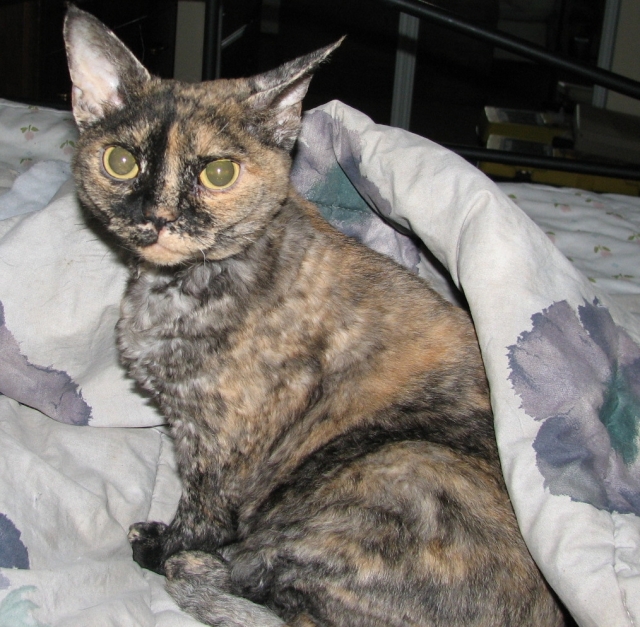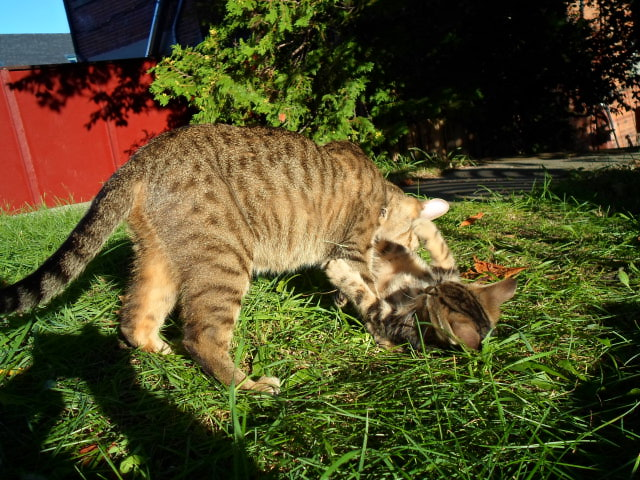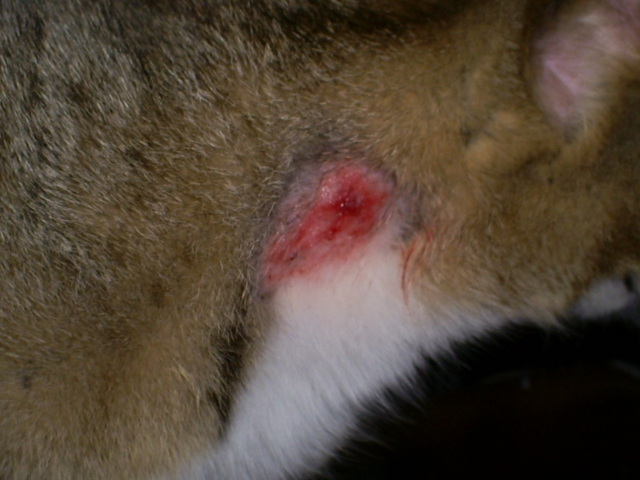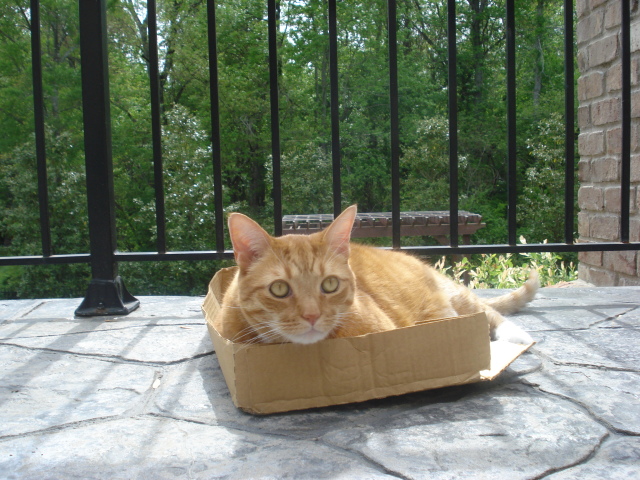QuestionHi Jessica,
I have two questions that I hope you'll be able to help me with.
We have a 1 year old orange female tabby (spayed) that we've had since she was a kitten and within the last several months we adopted a stray Siamese, a 3 year old neutered male.
The Siamese stalks, chases, and fights with the tabby (both have their claws). We keep them separated at night, but often they are left together during the day. When we are around and the Siamese chases the tabby, we put the Siamese in the finished basement for awhile to separate them. We thought this would get better over time, as our vet said it was probably the Siamese trying to exhibit dominance, but I think there may be something else going on. It hasn't gotten better, and my wife just found some sore spots on the tabby that we think are from the fighting. Would declawing the Siamese help? We don't want to do this and would only do it as a last resort. This has also caused the tabby to be fearful (understandably!).
My second question is about the Siamese. Since we've had him the back half of his coat(midsection to rump) has gotten darker and has also gotten several (more and more) small pure white spots of fur. I have read some about this on the internet, but am interested to know if we can reverse either or both conditions (the darkening and white spots) and what may be causing it.
Thanks!
Craig
AnswerHi Craig. While Siamese breeders and lovers will deny that Siamese cats are often bullyish, I just cannot say this is the truth. Many (not all, of course) seem to find dark amusement in striking fear into other cats in the household. All but one of my Siamese have been this way, and I've owned MANY. They are the greatest companions to humans on earth, but they really are a people cat.
Believe it or not, it can take many months, and even years for cats to begin to tolerate each other. I have a Siamese who is 4 years old, who STILL does not get along with the other cats all the time. However, she has much improved over the last year or so and can be caught cuddling with the other cats from time to time.
I haven't yet found a way to help prevent a Siamese cat from picking on those less confrontational, except to provide the poor kitty on the receiving end of the aggression with her own territory. Cats, unlike dogs, can be dominant in certain areas, while submissive in others. If you provide a place where your tabby can go for refuge, she might start to establish it as her territory. There, the Siamese would be submissive and wouldn't be as likely to attack.
We have accomplished this a few ways. One was to purchase a large dog kennel and keep it covered on all sides but one. This is where our Abyssinian, tortured by one of the Siamese, took up residence. It was large enough for her bed, litter box, and food and water bowls. When she felt threatened by the Siamese, she'd retreat to her crate, and the Siamese would leave her alone there.
Another way has been to separate the house into two parts with a glass or screen door. Our Siamese stays in one half of the house with other cats who can stand up to her, and the ones who are more mellow stay in the other side. While it may seem inconvenient, all are happy, so it's worth it.
Declawing would not help. In fact, it's likely to make things worse. Cats who are declawed automatically turn to their second line of defense - their teeth - since the first has been taken away. A cat bite is a hundred times (my own rough estimate) more dangerous than a scratch. Studies show between 80% and 90% of bite wounds become infected. They can result in abscesses that can cause serious problems, including high fever, and even blood infections, causing kidney, heart, or liver failure. They can also be quite costly to cure, as they may need shunts and/or hospitalization to drain. So, I would not recommend declawing at all.
However, what I DO recommend is a product called Soft Claws (used to be called Soft Paws, but they're the same thing). I have used these myself in cats who scratch aggressively, and I can't say enough about them. They're flexible, rounded vinyl caps that are glued over the cat's natural claws. They prevent any scratches, and also prevent furniture damage, etc. A vet invented them as an alternative to declawing. I have found them easy to apply, and my cats have never even noticed they're wearing them. They run about $15 for 4 sets of 10. They need to be replaced every 4-6 weeks as the cat's nails grow out. Some cats whose activiy levels are higher may lose a cap once in a while, and you'll just need to replace it with a new one (trim the natural nail before doing so). You can learn more on their website, www.softclaws.com. They can also be purchased at pet stores.
Aggression is often due to anxiety, too. And recent studies show that the Siamese breed may be predisposed to anxiety, which would explain many idiosyncrasies of the breed. There is a product called Feliway that is excellent for reducing anxiety in cats. It's a synthetic facial pheromone, a hormone cats release through their cheeks that helps calm them. It is a great tool to use to combat aggression. Additionally, it should help calm your tabby's fears. You can find out more through their website, www.feliway.com, or purchase it in pet stores. I recommend the plug-in diffuser over the spray. I have used both and find the plug-in much easier and more effective.
In extreme cases of aggression, anti-anxiety drugs can be given. One that has proven to be especially successful in aggressive cats is clomipramine (Clomicalm). One of my friends has to use this in one of her cats and has found it to be a miracle drug for a cat so aggressive, she almost had to be put to sleep. I know a prescription is the last thing people want to try, but I have used other anti-anxiety medications in my cats and can assure you that it is only fair to give them a shot. Remember, if your cat is living with constant anxiety, he is feeling just as terribly as you are about the situation. Ask your vet if this would be an appropriate avenue to take if all else fails.
To address your second question, the darkening of the flanks is a natural occurrence in the Siamese breed. The coat of the Seal Point, the darkest color, gets very dark by the time the cat is 4-5 years old, and the cat can turn almost completely black-brown in their senior years. The other colors will do the same thing to a lesser extent. There's no way to reverse this. It's simply the nature of their coloration. It's for this reason that you rarely see Siamese cats older than 2-3 years old in a show ring. Their color becomes too dark to fit the description of the perfect Siamese color pattern.
Small pure white spots could be due to a number of things. Perhaps he is not a purebred. Many Siamese mixes look fully Siamese but will develop color variations in their coats as they age.
Antibiotics are also well known for causing white patches or a brindle effect. Usually, these will go away when the coat regrows after the antibiotic has been discontinued. That can take 3-6 months.
You may have heard of a condition called vitiligo, which causes patches of loss of pigment in the skin in humans. Siamese can also be affected by this, causing white spots in the darker areas of the coat. However, it is rare in cats. In fact, only a few cases have ever been reported. There does not seem to be any negative effect of vitiligo in cats, but it cannot be resolved.
Hopefully, this has given you a starting point to work toward resolving your situation.
Best of luck,
Jessica

 cat identification
Question
pic was from my phone,
i am currently f
cat identification
Question
pic was from my phone,
i am currently f
 My cat is jealous of my other cat
QuestionQUESTION: Hi Ali. I hope you can provide
My cat is jealous of my other cat
QuestionQUESTION: Hi Ali. I hope you can provide
 Cat Breed Identification?
Question
Playtime Pretty Girl
Hi there. &n
Cat Breed Identification?
Question
Playtime Pretty Girl
Hi there. &n
 My cat is loosing hair .
Question
A picture of the probl
My cat is loosin
My cat is loosing hair .
Question
A picture of the probl
My cat is loosin
 Im terrified... my cat may be dying
Question
My Edward
First of all I want to thank you for
Im terrified... my cat may be dying
Question
My Edward
First of all I want to thank you for